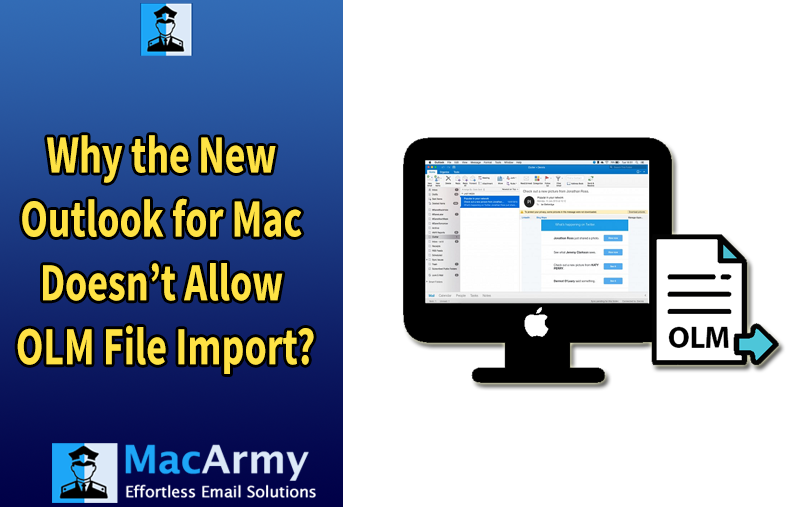Why the New Outlook for Mac Doesn’t Allow OLM File Import: Explained

Microsoft’s Outlook for Mac has been a reliable choice for many users who want a smooth and efficient email experience on their Apple devices. However, with the latest versions of Outlook for Mac, users have encountered a frustrating limitation the option to import OLM (Outlook for Mac Data File) files is no longer available. In this blog, we’ll explore the reasons behind this change and explain why the new Outlook for Mac doesn’t allow OLM file import anymore.
Understanding OLM Files:
Before exploring the issue in detail, it’s important to understand what OLM files are. OLM files are Microsoft Outlook for Mac’s proprietary format used to store emails, contacts, calendars, and other data. Users typically create these files when exporting or backing up their Outlook data. Importing OLM files has traditionally been essential for those upgrading Outlook versions or moving data to a new Mac.
The Shift to the New Outlook:
With the introduction of the new Outlook for Mac, Microsoft overhauled the app’s architecture and added various enhancements aimed at improving performance and user experience. However, this redesign also meant that support for importing OLM files was removed. As a result, many users who depend on OLM files for migrating or restoring their data have found themselves unable to do so, leading to considerable frustration.
Possible Reasons Behind the Limitation
Several key factors may explain why the new Outlook for Mac no longer supports importing OLM files:
Technological Shift: The new Outlook for Mac is likely built on an updated technology stack that isn’t compatible with the older OLM file format. Microsoft’s drive for modernization and stronger security standards could have led them to phase out support for legacy file types like OLM.
Cloud-First Strategy: Microsoft is heavily investing in cloud-based services, encouraging users to store emails, contacts, and calendars online for seamless access and collaboration. This focus on cloud storage reduces the reliance on local data files such as OLM, which may explain why import functionality has been limited.
Enhanced Performance and Stability: By dropping support for older file formats, Microsoft can optimize the new Outlook’s performance and stability. This trade-off helps provide users with a faster, more reliable experience, even if it means losing backward compatibility with formats like OLM.
How to Get Rid of the Issue? Solutions and Remedies
If you’re struggling to import OLM files into the new Outlook for Mac or dealing with related software limitations, here are some practical steps to help you overcome the problem:
1. Update Outlook for Mac – Always make sure you are running the latest version of Outlook for Mac. Microsoft regularly rolls out updates that improve features, fix bugs, and address compatibility issues. Updating your app might resolve the OLM import issue if it’s caused by a software glitch.
2. Verify File Compatibility – Double-check that your OLM file is not corrupted and was created using a version of Outlook for Mac compatible with your current app. Incompatible or damaged files can cause import failures, so confirming file integrity is essential before proceeding.
3. Repair the OLM File – If you suspect corruption in your OLM file, consider using trusted third-party repair tools specifically designed for OLM files. These tools can fix common file errors and recover your data. Make sure to choose reputable software to avoid further complications.
4. Convert OLM to PST Format – Since the new Outlook for Mac doesn’t support OLM imports, converting your OLM file to PST (a format compatible with Outlook on Windows and other email clients) can be a viable alternative. Specialized converters help you migrate your data without losing emails, contacts, or calendar entries.
How to Overcome the Issue with an Alternative?
The inability to import OLM files into the new Outlook for Mac might feel like a roadblock, but there are several alternative ways to work around this limitation:
1. Downgrade to an Older Outlook Version
If you urgently need to import your OLM files, consider uninstalling the new Outlook version and installing a previous version that still supports OLM imports. Once your data is imported, avoid updating Outlook until Microsoft releases a version that addresses the issue.
2. Use Third-Party Conversion Tool
Use reliable MacArmy OLM Converter for Mac are available that convert OLM files into the PST format. Since PST files are widely supported by Outlook (including some newer Mac versions and Windows Outlook), this method allows you to access your data without relying on OLM import capabilities.
3. Manual Migration
You can also manually migrate your emails, contacts, and calendars by exporting data from the old Outlook for Mac and importing it into the new one. Though this approach is more time-consuming, it provides greater control and customization over what you transfer.
Conclusion
While the removal of OLM import functionality in the new Outlook for Mac may be inconvenient, it reflects Microsoft’s push toward modernization and cloud integration. By exploring alternative migration solutions whether by downgrading, using conversion tools, or manual methods users can smoothly transition to the new platform without losing valuable data. Embracing these changes will help you adapt to the evolving Outlook experience on Mac.
